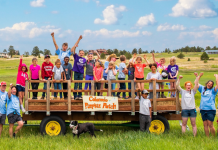 The first time my oldest hit a child he didn’t know on the playground, my face flashed red with hot embarrassment as I dragged my children quickly out of public view so I could cry my own tears in the privacy of the parking lot.
The first time my oldest hit a child he didn’t know on the playground, my face flashed red with hot embarrassment as I dragged my children quickly out of public view so I could cry my own tears in the privacy of the parking lot.
My kids don’t hit! I thought. How did this happen? What am I doing wrong?
I know now, of course, that children hit. It’s developmentally healthy for them to go through this phase. They are constantly learning new ways to control their emotions. Exploring the outlet that is physical aggression makes sense to them. But that doesn’t mean we should allow it.
BOYS WILL BE BOYS?
My boys are currently four and two years old. And boy, are they all boy. They love to wrestle with Daddy, tackle each other to the ground, and throw adorably vigorous punches that wouldn’t hurt a fly while they’re playing rough around the house.
But like most kids their ages, hitting and punching aren’t just for playtime. When my two-year-old is aggravating my four-year-old and the latter can’t talk him into stopping, he will often ball up his fists, grit his teeth, redden his face, and swing an open hand at his brother’s back or arm.
At home, this tends to be an easy fix. I separate the two and we take some time to calm down and talk about why they felt the need to hit. We talk about how hitting might make them feel, why it’s not nice, and why they shouldn’t do it. This is often followed by an apology and a hug and they go right back to tickles and giggles.
HITTING BROTHERS VS. HITTING OTHERS
But when we’re out—and there are other children around—the typical chaos of such situations requires more concrete rules of behavior. And for us, those rules are ever changing.
1. You are not allowed to hit, unless someone hits you first.
This was our first rule. It made sense to me. Never start a fight, but always finish it. That’s how the saying goes. It’s good old common sense self-defense—an honorable use of aggression even as an adult, right? And my child should not have to cower at the hands of a bully and take whatever that bully has to dish out. I wanted him to know that he could put someone in his place for hurting him.
What I learned from this, though, was that hitting sometimes happens accidentally, especially in crowded play places. And I was giving my child a reason to hit anyone who accidentally stepped on his toe, elbowed his face, or pushed him aside in their haste to race down the slide. Every time we asked him, “Why did you hit?” the answer was, “Because they hurt me first.”
This rule did not last long before it needed a revision. We told him that if someone hit him, he could ask them to stop. If they didn’t, he could choose to walk away and come find myself or his daddy, or whatever adult had come with him. But we knew aggressive hitting would still happen on the playground. Enter our second rule.
2. You are not allowed to hit, unless you see someone being hit.
This rule made me feel better. I want to teach my children to stand up for those who cannot stand up for themselves. I want them to know that bullying is not okay, and that if they see it, they should stop it.
Here’s how that went. During a recent visit to our favorite food/play place, my oldest child hit someone. The father of the hurt child stormed out of the play place looking for the adult in charge. This happened to be my sister-in-law. He explained loudly that my child hit his. He was angry that it happened and even more angry that my kid was now hiding in a corner like the guilty party he was instead of coming with this man to find his parents.
(As a quick aside, I commended my child later on not following a stranger—especially a seemingly aggressive one—out of the play place. But stranger danger is a discussion for another time.)
The account I later got from my son was that the other child had first hit his younger brother. While I have reason to believe that is true from other tidbits of the story, I also take it with a grain of salt. I was not there; my sister-in-law did not see what actually happened; and an angry parent (who I suspect did see the entire event) failed to mention that part of it. My son also is now old enough and bright enough to understand how lying works. Another one of those frustratingly normal milestones.
My takeaway from this incident is that I have been giving my child an excuse to hit other children. I have been telling him “it’s wrong to hit, except under these circumstances.” And he’s run with it every time.
Whether or not he was defending his brother in this instance isn’t as relevant as the fact that he knows he can get away with hitting. He just needs the right story. Time for the third rule.
3. You are not allowed to hit. Period.
Our current strategy is to take away the excuses all together. Of course, playground “violence” will still occur, and it may even be at the hands of my children. But I will no longer be the parent who tells my child it’s okay for them to hit, even under special circumstances.
But what if someone hits me? You can choose to walk away and come find me or keep playing.
But what if someone hits my brother? Tell them to stop. Then go to your brother and make sure he’s ok. If he isn’t, help him find me or Daddy. If he is, invite him to come play with you, instead.
Bottom line: You don’t have to hit just because someone else has. And if you do hit, whether in anger or retaliation, there will be consequences. This might mean taking a break from playing or leaving the play place all together. Either way, you no longer have a valid excuse for hitting.
IGNORE THE BULLY
My idea for this last approach came from a comic strip I read almost a year ago that addresses how a bystander can serve to protect someone who is being harassed. The strip focuses on harassment of the Islamophobic type, but the strategy works for diffusing all kinds of harassment. The most important thing is to engage the victim and ignore the aggressor, stay with the victim until the aggressor leaves, and make sure that the victim is able to reach a safe place if necessary.
While that is much too heavy a concept for my little ones right now, I don’t think for a second that it is too ambitious to teach them compassionate ways to deal with bullying even at this age. Conversely, teaching them early that it is okay to hit as long as there is a good reason for it perpetuates the idea that some violence is justified, and that’s not a road I want to lead my children down.
If an eye for an eye leaves the whole world blind, a hit for a hit leaves the whole playground in tears. It just isn’t worth it.













